Known scientifically as Coriandrum sativum, Coriander (Dhaniya) is an annual herb. Fruits and tender green leaves are the main reasons for their cultivation. Several states in India grow this plant, including Andhra Pradesh, Tamil Nadu, Karnataka, Rajasthan, and Madhya Pradesh. Most of the production is consumed locally, and a smaller percentage is exported.
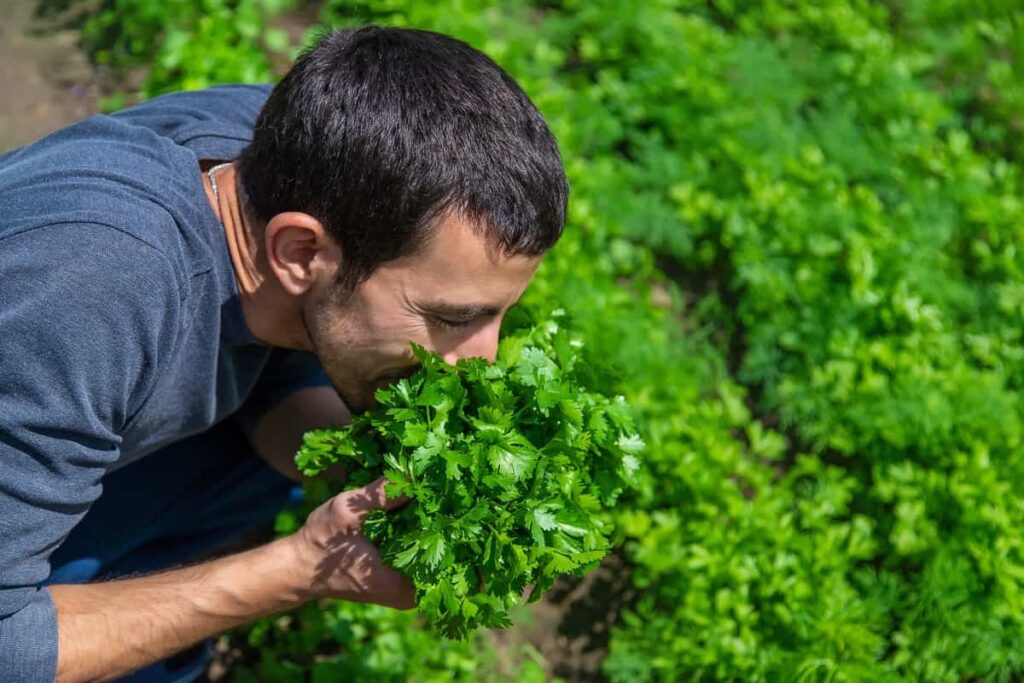
Aromatic odor and pleasant taste characterize the fruits. Depending on the essential oil content, dry seeds have an odor and taste between 0.1 and 1.0 %. These essential oils are used for flavoring liquors and coca preparations in confectionary, and to mask offensive odors in pharmaceutical preparations.
Growing Coriander organically in Madhya Pradesh
How the Madhya Pradesh government supports organic farming
Organic farming has been a popular practice in Madhya Pradesh for many years. Madhya Pradesh accounts for more than 40% of India’s organic farming share, with more than a lakh organic farmers registered. As indicated in the APEDA report for 2020-21, the state exported five lakh tonnes of organic products. Some districts that practice organic farming are Mandla, Dindori, Balaghat, Chhindwara, Betul, Katni, Umaria, Anuppur, Umaria, Damoh, Sagar, Alirajpur, Jhabua, Khandwa, Sehore, Sheopur, and Bhopal.
Under PKVY, groups of farmers will be motivated to take up organic farming by forming a cluster with 50-acre land. There will be no liability on farmers for expenditure on certification. Every farmer will be provided Rs 20,000 per acre in three years for the seed harvesting of crops and transporting produce to the market.
Using traditional resources will promote organic farming, and the organic products will be linked to the market. Besides PKVY, the government promotes organic farming through various schemes such as the National Mission for Sustainable Agriculture, Rashtriya Krishi Vikas Yojana, Mission for Integrated Development of Horticulture, National Mission on Oilseeds and Oil Palm, and Network Project on Organic Farming of ICAR.
In case you missed it: Growing Potatoes Organically in Uttar Pradesh: Varieties, Cultivation Practices, and Production Management
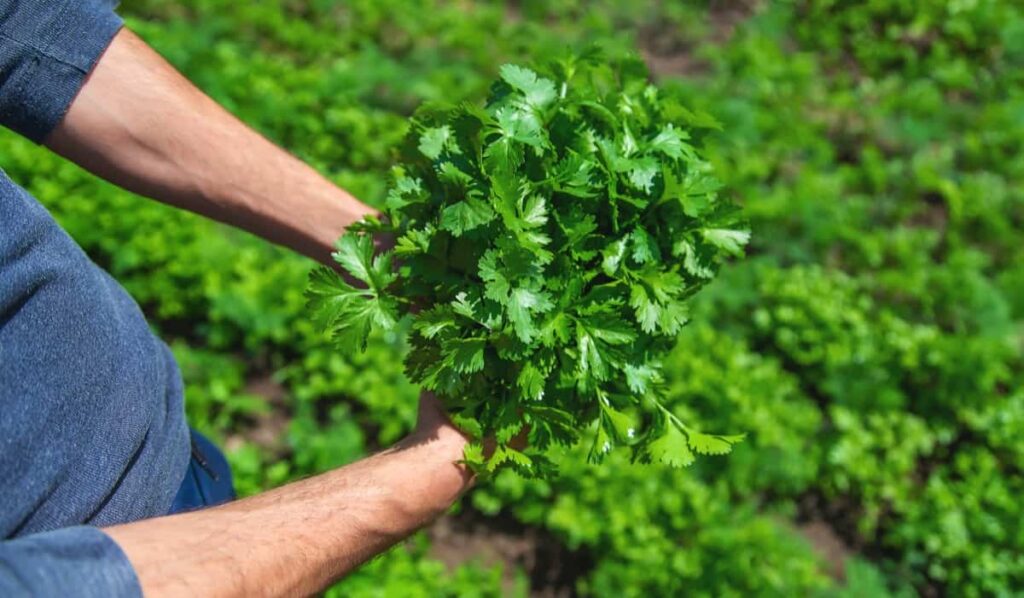
Coriander varieties
CO1
- TANU, Coimbatore, released it.
- The plant is taller, with many umbels per plant.
- It is suitable for green and grains.
- The crop duration is 110 days, while the yield is 200 kg per acre.
CO2
- Released by TANU, Coimbatore.
- It has high yield potential with dual-purpose variety.
- It is tolerant to drought with essential oil 0.3%.
- The crop duration is 90-110 days. Yield 240-280 kg per acre.
CO3
- Released by TANU, Coimbatore.
- Its grain is medium-sized and has high yield potential with a dual purpose.
- Its seed oil content is 0.38-0.41%.
- The crop duration is 103 days, and the yield is 160 kg per acre.
Gujarat Coriander-1
- GAU, Jagudan, released it.
- It is a high-yield variety with more branches, with bolder and greenish seeds.
- Duration 112 days. Yield 220 kg per acre.
Gujarat Coriander-2
- Released by GAU, Jagudan.
- It is a high-yielding variety with more branches, dense foliage, and a large umbel size.
- It is a grain-purpose variety of bold seeds with no lodging.
- The crop duration is 110-115 days and has a yield potential of 600 kg per acre.
Rajendra Swati
- It was released by RAU, Dholi.
- Its yield potential is high and suitable for intercropping,
- It is a fine-seeded variety, rich in essential oil, and resistant to stem gall disease.
- The crop duration is 110 days, with a yield potential of 480-560 kg per acre.
Rcr-41
- RAU, Jobner, released it. It is a high-yielding variety.
- It is tall, erect, and suitable for irrigated areas
- This variety is resistant to stem gall.
- The crop duration is 130-140 days, with an average yield of 480 kg per acre.
Sadhana
- APAU, Guntur, released this variety. It is high yielding and suitable for rainfed areas.
- It is a semi-erect variety resistant to aphids and mites.
- The crop duration is 95-105 days, with a yield potential of 400 kg per acre.
In case you missed it: Profitable Organic Eggplant/Brinjal Cultivation in West Bengal: A Production Guide for Beginners
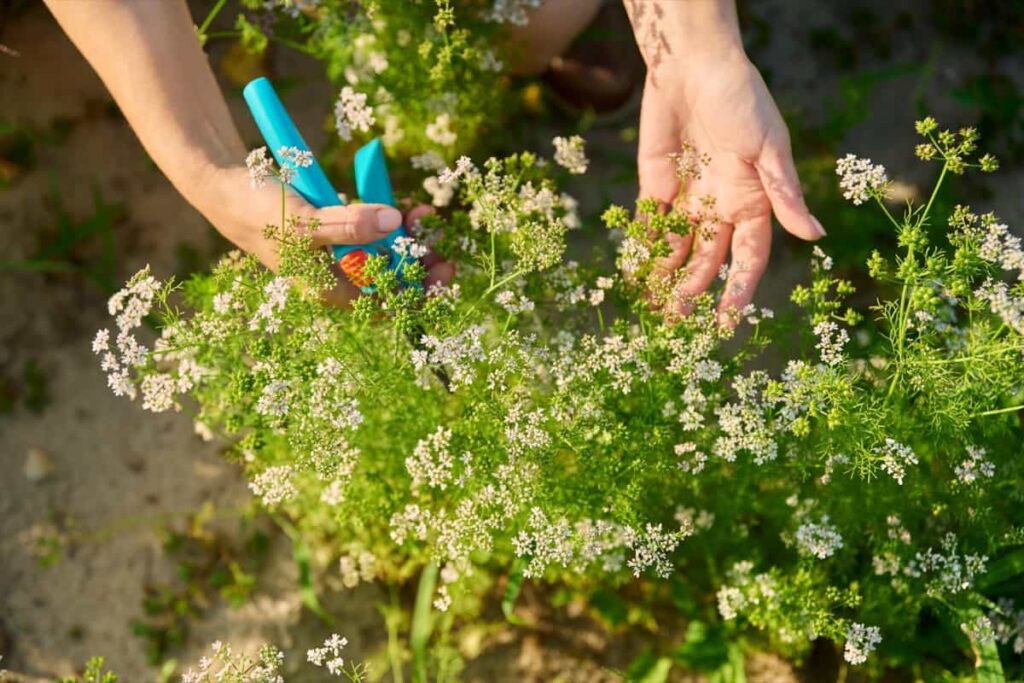
Climate requirements for growing Coriander
Traditionally, Coriander, or Dhaniya, has been used for its leaves. However, it must be grown during a specific season for a higher grain yield. It is best to grow grain during dry, cold, frost-free weather, particularly during the flowering and fruit-setting stages. When flowers and fruit are in bloom and fruiting, cloudy weather is not ideal as it supports pest attacks and diseases. In contrast, heavy rain damages crops.
Soil requirements for growing Coriander
The Coriander can be grown in any type of soil suitable for cultivation. It is cultivated both as irrigated and unirrigated crop. Almost any soil with sufficient organic matter can be cultivated as an irrigated crop. Still, dry land crops may be taken only on heavy soils having good water retention capacity. Saline, alkaline, and sandy soils are not suitable for its cultivation. pH range of soil should be 8-10.
Preparation of land for cultivating Coriander
Land should be prepared well by giving 2-3 deep plowings followed by planking to make uniform and leveled beds. Before the last plowing, add 40 quintals per acre of well-decomposed cow dung to the soil. After heavy rain, the field must be planted immediately to break the clod and to avoid soil moisture. The land is plowed twice or thrice for irrigated crops, and beds and channels are built then.
Season to cultivate Coriander
In the north and central parts of India and Andhra Pradesh, Coriander is grown as a Rabi season crop. Sowing or seeding is done between the middle of October and the middle of November, depending on the region. It is also grown as a late Kharif crop in certain areas of the states mentioned above, and its planting season sometimes falls between August and September, depending on the region of the state.
Coriander seeds sowing in the main field
Coriander is cultivated as an irrigated crop in Madhya Pradesh from June to July and September to October. The recommended seed rate for an acre of land is between 4 and 6 kilograms. Seed seeds stored for 15 – 30 days and then planted have produced higher yields and germinated sooner than those harvested fresh. Seeds should be soaked for 12 to 24 hours before sowing to boost the germination percentage.
It is necessary to split the seeds in half by rubbing them between two pieces of paper, and the seeds are then sown through broadcasting or line sowing methods. However, the broadcasting method is not advisable due to the difficulties associated with intercultural communication. As a result, it is recommended that the Coriander be sown at a 25 to 30 cm line-to-line spacing, while the distance between the plants should be kept at about 10-15 cm.
For a maximum grain yield, the line-to-line spacing between the coriander plants should be kept at 30 cm. Ideally, coriander seeds should be sown at a depth of 2 to 3 cm and covered with a country plow after sowing. The time it takes for coriander seeds to germinate normally varies between 10 and 15 days.
Irrigation guidance for the cultivation of Coriander
Depending upon the soil and weather conditions of the growing area, 2-3 irrigation in black cotton soil and 4-5 irrigations in light-textured soil are required to cultivate Coriander successfully. The first irrigation should be given as soon as the seeds are sown. The critical stages for irrigation are the seedling stage (30-40 DAS), grand growth period (50-60 DAS), and seed formation stage (90-100 DAS). Irrigation with drip or sprinkler may also be given to save water and nutrients. The standard irrigation schedule is 5–6 irrigations 30–35, 60–70, 80–90, 100–105, and 110–150 days after sowing.
Manure application in Coriander crop
Apply 4-6 tons of farm yard manure or compost per acre 3 weeks before sowing the crop. A study at NRCSS Ajmer found that sheep manure and Azotobactor gave a maximum yield of Coriander. In a dry land coriander crop, mix 10-15 t of well-decomposed farm yard manure or compost one in 2-3 years.
Organic weed control in Coriander crop
In unirrigated crops, there is no need for an intercultural operation. In irrigated Coriander, 2-3 weeding is necessary for keeping the crop weed free. The first weeding and hoeing operation is required 30-40 days after sowing, and the second at 60-65 DAS. The critical stage of 52 days for weed crop competition in Coriander has been standardized. Weeding and hoeing are necessary to keep the crop free from weeds.
In case you missed it: Growing Pomegranate Organically in Maharashtra: Farming Practices and Production Guide
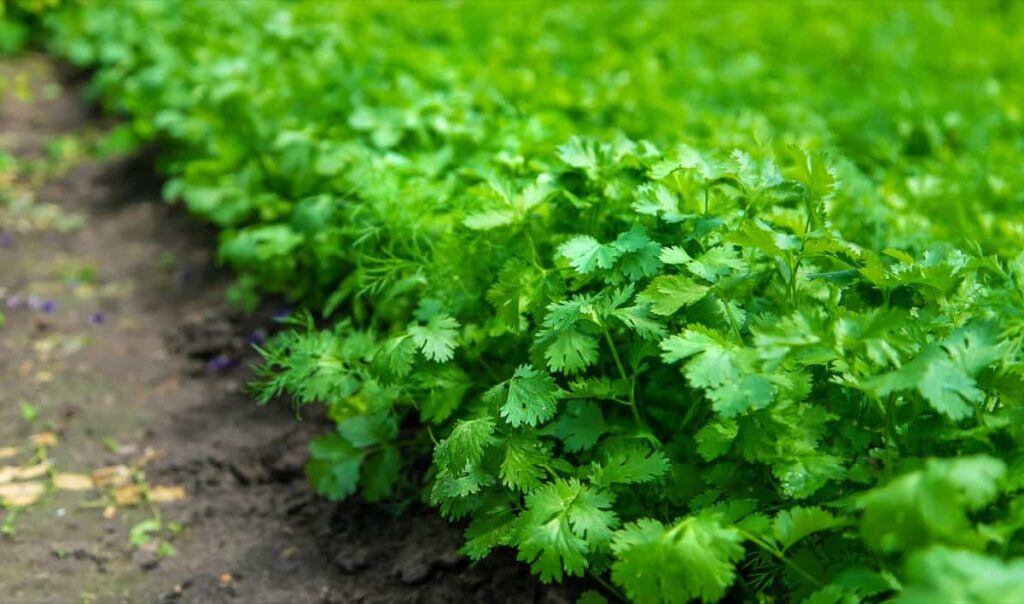
Major pests in Coriander and their organic control
Aphids
Damage symptoms
- If there is a heavy infestation of aphids, the leaves may turn yellow and become distorted
- Leaves and shoots are stunted and are covered in necrotic spots
- Honeydew is a sticky, sugary substance secreted by aphids, which encourages the growth of sooty mold on plants.
Control and management
- Aphids can be deterred from feeding on plants by using reflective mulches such as silver-colored plastic.
- Spraying strong jets of water on sturdy plants will knock off aphids
Armyworm
Damage symptoms
- In foliage, circular to irregularly shaped holes can be found alone or in clusters.
- Skeletonized leaves result from heavy larval feeding.
- A whitish scale covers egg clusters, which gives them a cottony or fuzzy appearance.
Control and management
- The application of Bacillus thuringiensis and natural enemies which parasitize the larvae are the two most effective biological control methods
- Spinosad can be detrimental to natural enemies like syrphid flies, predators of aphids, and other soft-bodied insects.
Cutworms
Damage symptoms
- In fruit, irregular holes are eaten into the surface.
- In most cases, larvae that cause damage to plants are active at night and hide during the day in the soil at their bases or in plant debris from toppled plants.
- While larvae may display various patterns and colors, they usually curl up into a C shape when disturbed.
Control and management
- Ensure all plant residue is removed from the soil after harvesting or at least two weeks before planting.
- The base of the plants should be covered with diatomaceous earth.
Major diseases in Coriander and their organic control
Bacterial leaf spot
Disease symptoms
- The small spots that are soaked in water between leaf veins enlarge and become dark brown or black as they enlarge
- A dark streak may run down the stems
- Yellowing and browning of inflorescences as well as blighted and water-soaked lesions
Control and management
- Avoid overhead irrigation and do not work with plants when they are wet
- Rogue the infected plants from seed fields to reduce the secondary spread and the risk of producing infected seeds.
In case you missed it: Key Rules to Grow Organic Mangoes in Uttarpradesh: Varieties, Cultivation Practices, and Production Management
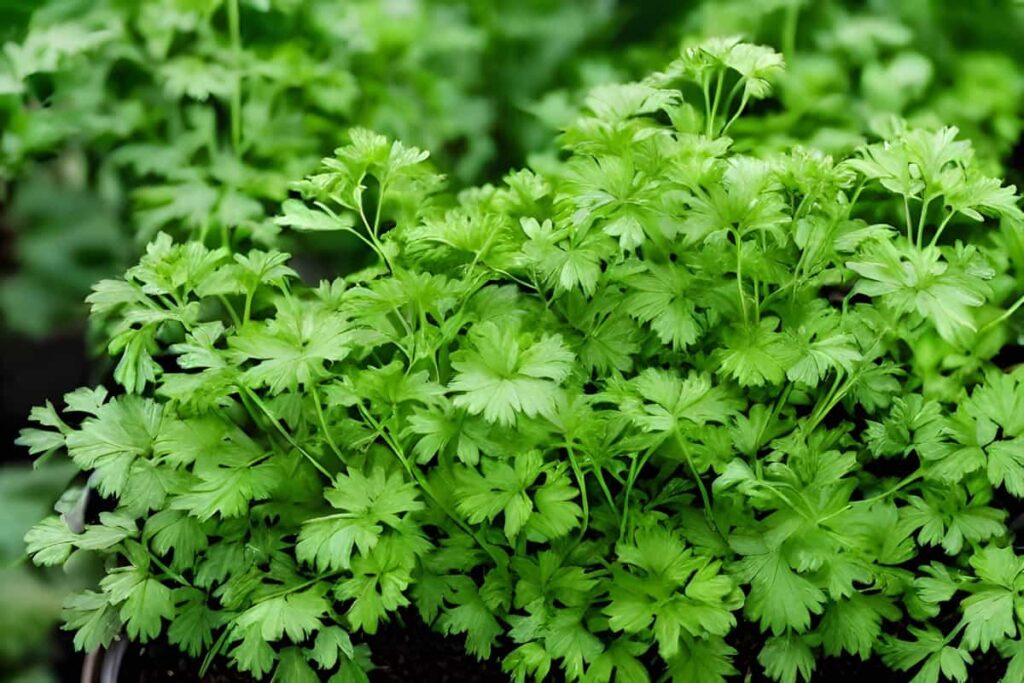
Soft rot
Disease symptoms
- Small water-soaked spots appear at the base of petioles.
- These spots cause the soft tissues to become mushy and brown.
Control and management
- Avoid overwatering and allow the plants to dry before each watering.
- Remove the infected plant parts as soon as you can.
- Avoid overcrowding the plants. Ensure wide spacing between plants for good ventilation.
Damping-off
Disease symptoms
- Soft, rotting seeds which fail to germinate and rapid death of seedlings before emergence from soil
- Water-soaked reddish lesions girdling the stem at the soil line cause seedlings to collapse after they emerge from the soil
Control and management
- Plants should not be planted in wet, cool, poorly draining soil.
- Raised beds will improve soil drainage and encourage fast germination of high-quality seeds.
Harvesting and yield in organically grown Coriander crop
The crop normally gets ready for harvest in about 90 to 110 days depending upon the varieties and growing season. When the crop attains 20-25 cm height, harvesting for green leaves can be started. Three to four cuttings can be taken. When a crop is grown for seed, it is ready for harvesting in April. Harvest, when the capsule gets, matures but has green color. Over-ripen capsules fetch a lower price.
Harvesting should be considered once the seeds ripen completely and change from green to brown. In the harvesting process, the plants are cut or pulled and poled into small stacks to beat with sticks or rub with hands. Then, the produce is winnowed, cleaned, and dried in partial shade. After drying, the product is stored in gunny bags lined with paper. The yield of Dhaniya as a rainfed crop on average is between 160 to 200 kg/acre, while the yield for the irrigated crop is between 240 to 480 kg/acre. Coriander leaf yield is 2.5 to 2.8 tons per acre.
In case you missed it: Growing Pineapple Organically in West Bengal: Farming Practices and Production Guide
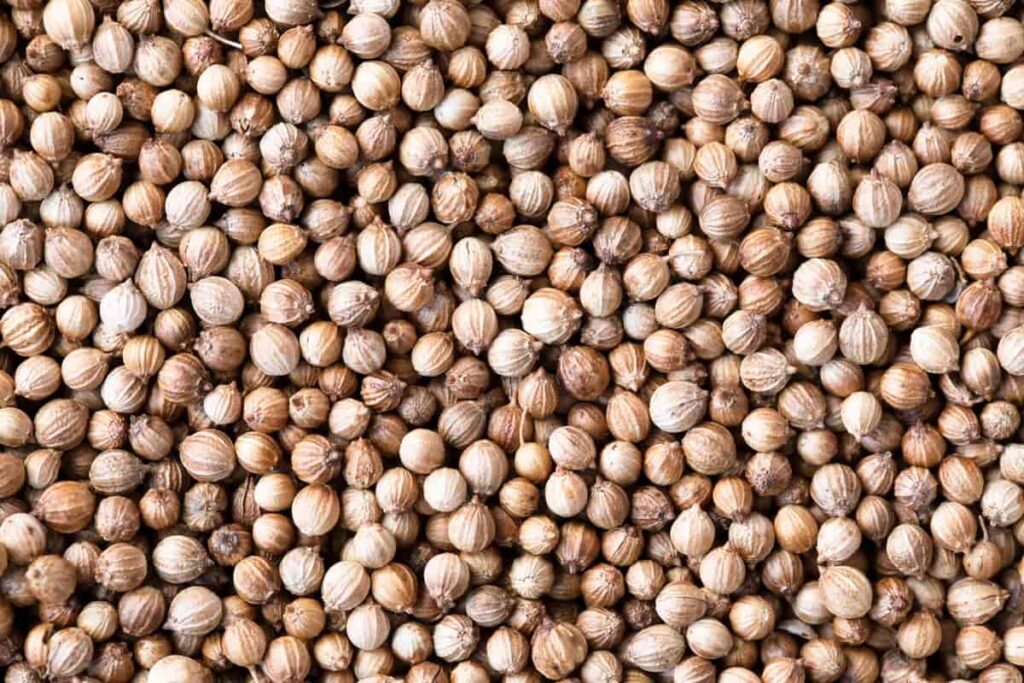
Conclusion
However, both coriander leaves and seeds have very good demand and value in the market. And starting commercial coriander farming is very easy and simple. Commercial or large-scale coriander farming is a popular business in many countries worldwide. It is very common and popular as a vegetable and is also consumed raw.
- How to Raise Pigs in Your Own Backyard: A Comprehensive Guide
- Budget Friendly Sheep Shed Ideas: Cheap and Low-Cost Tips
- How Much Do Cattle Farmers Make: Revenue Streams in Cattle Farming
- Management Pests and Diseases in Your Cotton Field
- Sheep Farming Business Plan for Beginners
- Aquaponic Farming at Home: A Step-By-Step Guide
- Profitable Village Farming Business Ideas in 2024
- High-Yield Aquaculture: Fast-Growing Fish for Farming
- Effective Fish Pond Construction Techniques for Beginners
- Irrigation and Water Management in Pineapple Farming
- Blossom to Harvest: Mastering Flowering and Pollination in Papaya Farming
- Pig Fattening Essentials: From Selection to Sale for Beginners
- Raising Wagyu Cattle: A Complete Guide for Premium Beef Production
- Soil Types and Their Water Holding Capacity
- Optimizing Irrigation Schedules for Coconut Groves for Enhanced Yield
- Espresso Your Garden: Coffee Grounds for Healthier Acid-Loving Plants
- The Best Soil Mix for Snake Plants: How to Mix Your Own Snake Plant Soil
- Green Thumb Success: Expert Tips for Cultivating Greenhouse Beans All Year Round
- Bloom All Year Round: The Ultimate Guide to Indoor Hyacinth Care
- Eco-Friendly Gardening: How to Make Liquid Fertilizer from Kitchen Waste
- Ultimate Guide to Grow Anise in Pots: Explore Seed Propagation to Harvesting
- Guide to Raising Chester White Pigs: Discover Breed Facts to Growth Management
- Mastering the Elegance: The Ultimate Guide to Weeping Cherry Tree Care, Planting, and Maintenance
- Ultimate Guide to Planting Garlic in Grow Bags: Growing Strategies for Beginners
- How to Fix Spider Plant Leaf-Related Problems: Natural and Organic Remedies
- 10 Reasons Why Your Tulsi Plant is Shedding Leaves: Home Remedies and Solutions
- Optimizing Growth and Yield: The Advantages of Palm Bunch Ash Fertilizer
- Utilizing Neem Oil Extract as a Natural Pesticide for Hydrangea
- From Soil to Harvest: Various Ways in Which Farmers Can Use AI Tools
- Steps to Encourage and Induce Citrus Flowers: A Comprehensive Guide
- How to Fix Snake Plant Leaf-Related Issues: Natural and Organic Remedies
- Transform Your Garden into a Fragrant Oasis with Raat Ki Rani (Night Blooming Jasmine)
- Discover the Ideal Chicken Breeds for Philippine Farms
- How to Create a Poultry Egg Farm Business Plan for Profits
- Grow Lemon Cucumbers Like a Pro: Insider Techniques for Bountiful Yields
- Ultimate Guide to Caring for Your Pink Princess Philodendron: Tips for Thriving Variegation
